#Exotic Revival style
Explore tagged Tumblr posts
Text
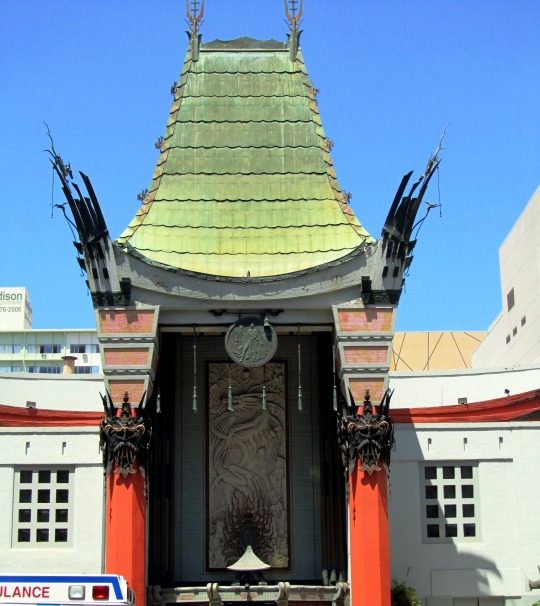
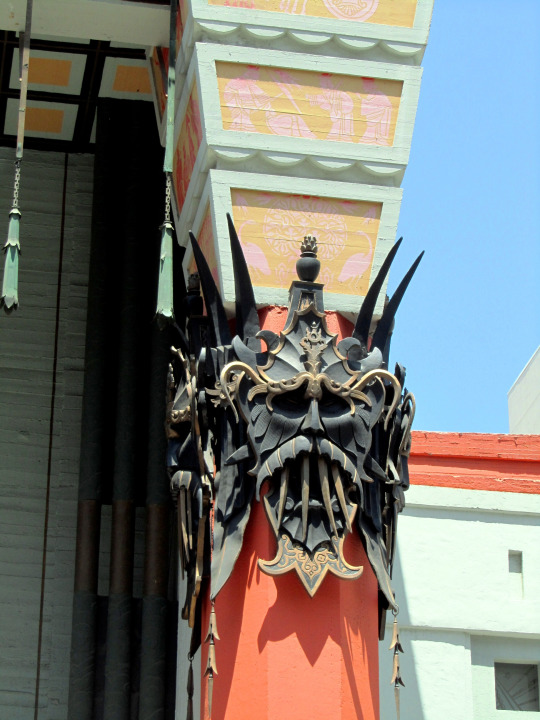
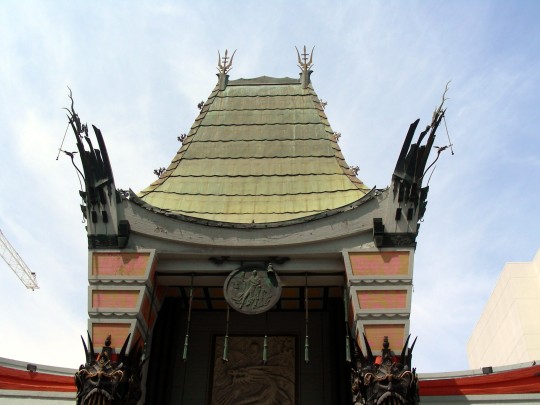
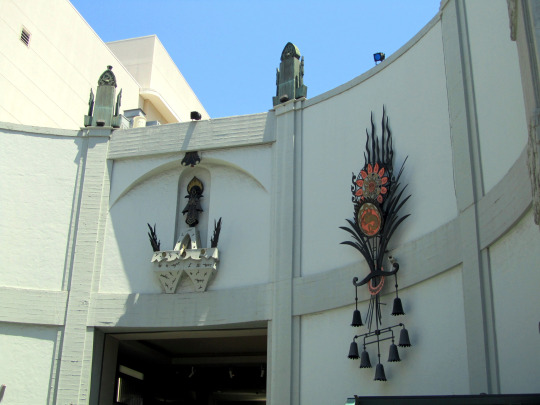
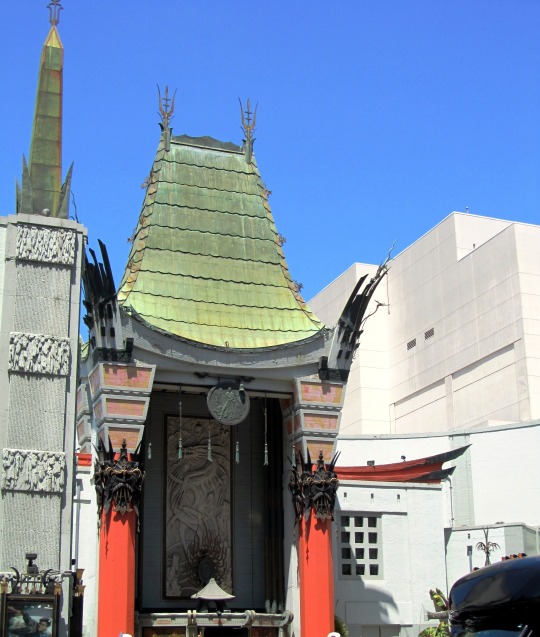
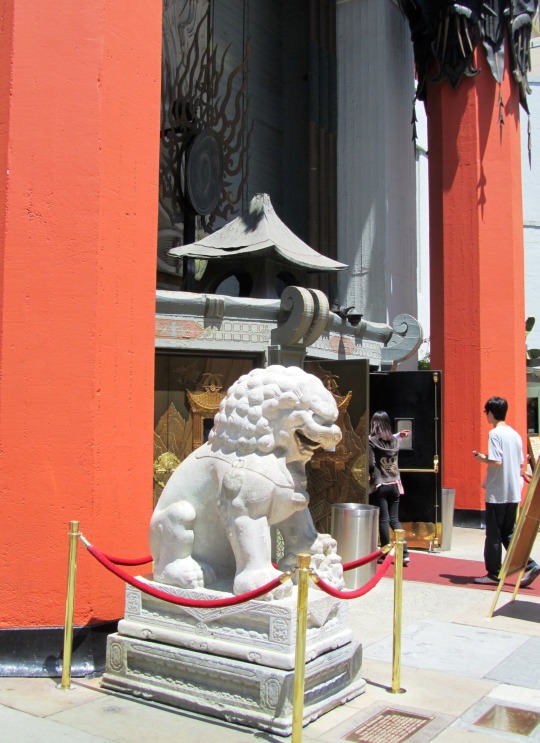
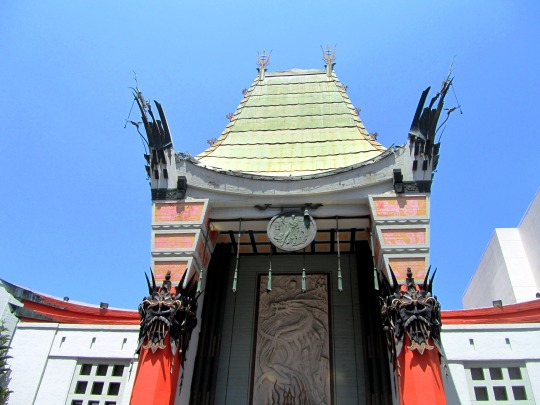
The Grauman's Chinese Theatre opened on May 18, 1927, with the premiere of Cecil B. DeMille's The King of Kings.
#Grauman's Chinese Theatre#opened#18 May 1927#anniversary#US history#TCL Chinese Theatre#Mann's Chinese Theatre#Grauman's Chinese Theater#Exotic Revival style#architecture#facade#detail#landmark#summer 2011#tourist attraction#Raymond M. Kennedy#Hollywood#LA#Los Angeles#USA#California#Hollywood Boulevard#cityscape#2008#vacation#travel#original photography
2 notes
·
View notes
Text
The return of the 80s "Yuppie"
Padded shoulders, bigger silhouettes, and aspirational wealth...hm this looks familiar

It is December 2024. After a year full of contemptuous politics and unprecedented weather events, the world feels like it is delving further and further into some sort of parallel reality—one where hate speech has become an everyday occurrence, intellectualism is shunned, and empathy is running severely thin.
What does this have to do with fashion? Everything.
Fashion holds a mirror up to times.
Cyclically, the fashion cycle is supposed to operate on a twenty year trend cycle, however, social media, fast fashion production, and the availability of disposable income has thrown this cycle off in the past five years. Technically we are supposed to still be knee-deep in 2000s fashion aesthetics but the industry has reported a mix of ever-present 90s nostalgia and 2010s indie sleaze lurking around the corner. However, there is one era that is slowly creeping in...
What do American Psycho, Quiet Luxury, and the Office SIren have in common?
youtube
The stereotype of the yuppie was the focus of American Psycho (2000) and can be summed up in this scene.
The 80s "yuppie" fits more in line with what preppy and falls more line with the "old money" revival. The "yuppie" is a slang term shorthand for Young Urban Professional. Born and bred the yuppies experienced a severe economic recession in the early 80s, followed by high inflation. In response to that when the economy finally stabilized and these young adults took their positions in high paying careers they projected a highly criticized image of excess and superficiality. In times of great financial insecurity and growing consciousness of the widening wealth gap the yuppie is a reviled but aspirational figure. Last year we saw waves of "old money aesthetic" and "quiet luxury" flood in, which both promoted an understated more austere style but I could see a more direct "yuppie" revamp coming our way with the renewed interest in preppy style.

The "Office siren", a microtrend that saw its rise to notoriety in 2024, combines the minimalistic aesthetics of the 2000s with workwear. The office siren is a simultaneous rejection and romanticization of corporate expectations, which in itself can be a form of power dressing. The office siren wears dark red lipstick , fitted oxford blouses, and heels that may pass as sensible but her shirt is slightly unbuttoned in a sexy and effortless way. The office siren can be read as Gen Z's response to entering the workforce, a point to breathe life into the corporate look we are now expected to conform to, The yuppie look is also one that grew one around the expectation to conform to a corporate environment.
"Mob wife" is a style that is more overtly attuned to 80's maximalism. It features color, exotic furs, textures, and excess. It is likely the result of continuing high inflation coupled with economic/political uncertainty that has people subconsciously craving material wealth in tangible and often louder ways.
Ready-to-wear in the past two fall/winter seasons has began to experiment with oversized silhouettes and colors. Multiple fashion journalists have decried big shoulders as a 2024 fall/winter trend.


Balmain Fall 2024 / Ferragamo Fall 2024

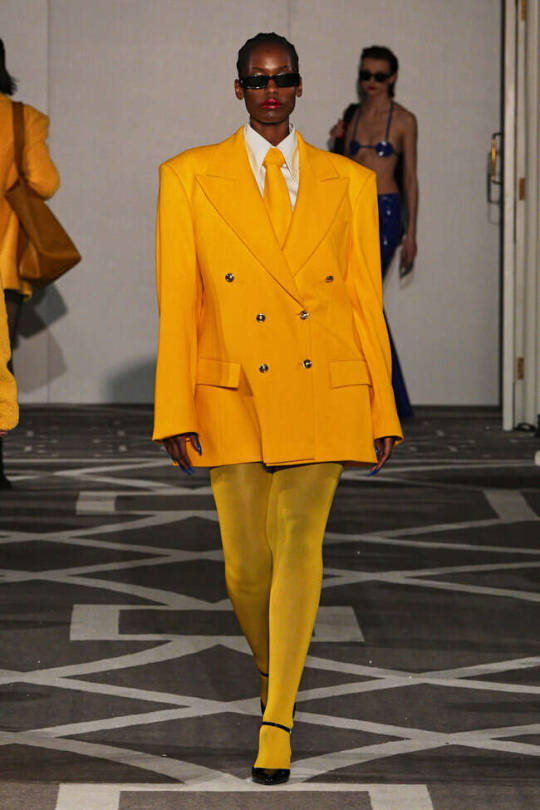
Dolce & Gabbana Fall 2023 / Helen Anthony Fall 2024
My prediction is that the fashion industry will begin to further incorporate 80's style it will eventually move into 80's power dressing which I can only imagine will lead them back to the polarizing inspiration. With all trends, the 80's will be back in a newer and re-interpreted manner. Even though I believe we will be seeing more visuals aligning with the yuppie look but there from a more nuanced and possibly deconstructionist viewpoint.
While I leave you to ponder these thoughts, feel free to listen Ginger Taylor's moody 'Yuppie' a fitting title for the song that powered today's blogging sesh.
No photos in this article are owned by me.
#Youtube#fashion#fashionblog#fashion blogger#fashion journalism#blog#girl blogger#miu miu#fashion week 2024#yuppie#eighties#Spotify
4 notes
·
View notes
Text
Okay, so time to talk about my first (technically first, it's complicated) destiny 2 OC. I've been playing the game for...... Awhile, and Everytime I had a build idea my first thought was always "I can make someone with this". It was sorta difficult before loadouts were added, but when they finally came I could actually gain attachments to my characters! For better or for worse. Anyway, focusing.


This is Pyre, or Pyre-3 to be specific, my main solar warlock. She is directly inspired by my preferred play style when doing solar, to blow everything up. As such, she was originally a sunbracer warlock before I got bored of that gameplay loop and the Osiris helmet ornament for Dawn Chorus was selling for dust, and everything just.... Clicked into place and, BOOM, Pyre was born.
Personality: Rather smart, but prone to acting before she can think. Likes to mess around when she gets the chance, using solar light to mess with the rest of her fireteam. But when push comes to shove, cares deeply about every member of her team and will stop at nothing to help them, no matter what she has to burn down.
Background: Revived in a desert (I'm not sure which particular one I'd put her in, but it's also likely a bunch of new ones came about because of the collapse, so....) by her ghost, Apep (More about him later). She would start out simply wandering and fighting the fallen that were scavenging whatever was usable. Eventually she stumbled upon another guardian and fellow Exo, a titan by the name of Autumn-5. They hit it off pretty quickly, forming a team and trying their best to make it to the city. This was made a lot easier when another guardian, a void hunter named Tyr landed (Crashed) while coming to the area to do a quick mission for the vanguard. After they lent him an assist, he gave them a ride back to the tower and joined their fireteam. From there, things pretty much follow the normal story of destiny. Killing the black heart, Crota, Prison of elders, Oryx, The siva crisis. All with the fire team slowly adding new members as time went on. And everything was fine.... Until
The Red War: Everyone already knows what happened during the Red War (Unless you're a super new player, because SOMEONE removed it for beyond light. Not even a timeline mission or anything) , so it should be no surprise that shit got real. Pyre, being the leader, went to confront Ghaul herself, with Autumn and Tyr accompanying her. Tyr stays back to make sure reinforcements don't catch up, leaving Autumn and Pyre to deal with the Dominus. From here, everything goes the same, except Autumn is knocked off the ship by an explosion, which is what distracted Pyre enough to lose to Ghaul before the light was taken. She woke up near the hangers and manages to get to Autumn's ship before using the last bit of her light to help some civilians flee the city. This is of course where stories split, with Pyre doing the titan storyline, Tyr and Autumn end up staying on earth helping civilians and discovering how to regain the light through the shard. Both groups grow as they meet friends old and new. Tyr and Autumn assume Pyre is dead until communications are restored and they finally find out she's alive. Pyre got visions telling her to go to the shard right before she went to titan, so that's why they barely missed each other. Tyr and Autumn immediately grab a ship and agree to meet up on nessus after receiving a call from a distressed hunter vanguard.
From here, things go normally with them eventually freeing the traveler.
I'd go into detail of other minor story stuff, but I'd be rambling at that point
Abilities: all the usual except I have her a unique super ability called "Delayed detonation". Basically covering the area in tracking solar light bomblets before detonating all of them in a chaining manner.
Loadout: While I personally use Dragonsbreath, the rocket sidearm from echos, and that one Saint themed scout, I did make a custom exotic just for her.
The Derby: a solar rocket sidearm that has two fire modes. The first is the normal shot, that simply causes a normal explosion with slightly higher than average radius. The secondary fire has a minor charge time and fires a sticky explosive that detonates after a delay. But if the primary is shot at the explosive it doubles it's explosive radius and damage, along with causing scorch to enemies in the radius depending on distance to the epicenter. The catalyst would give it incandescent.
Relationships:
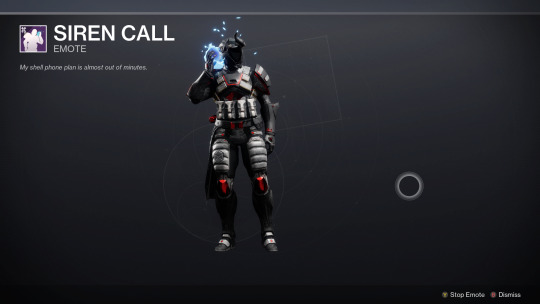
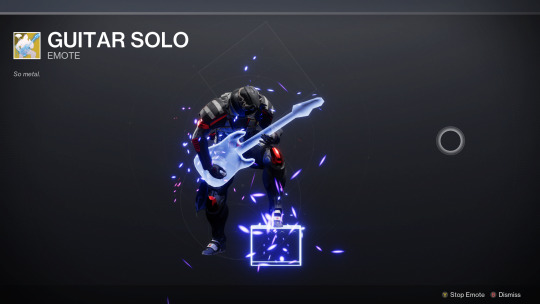
Autumn, her partner/girlfriend (did I forget to mention that? Yeah, I shipped my titan and warlock, whatcha gonna do about it >:3). Dispite the time and events they've been though, is always a loyal companion (will get her own thing at some point when I get to titans). Personally crafted The Derby as a gift to Pyre.
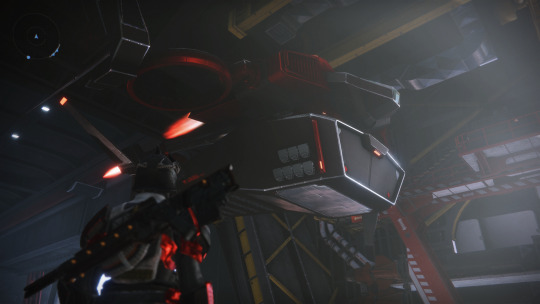
They live together in their jumpship (It's larger than it looks in my head, okay?). Not because they can't afford an apartment, but because they prefer to always be ready.

Pyre's ghost, Apep. He's a strange little guy, holding himself highly. He is also the only thing stopping Pyre from burning everything around her down by being one of the few sane-ish people in her life. He was honestly expecting a much more manageable guardian, but Pyre has grown on him through the years.
That's about it for Pyre...... God, I wish I had any art skill. You have no idea how much I want to draw Pyre and Autumn hugging. It's a lot. Like a LOT. Well anyways, enjoy!
3 notes
·
View notes
Text
Eric and her Builds. All with dripped out Dresstiny because you can't kill aliens if you don't look cute!
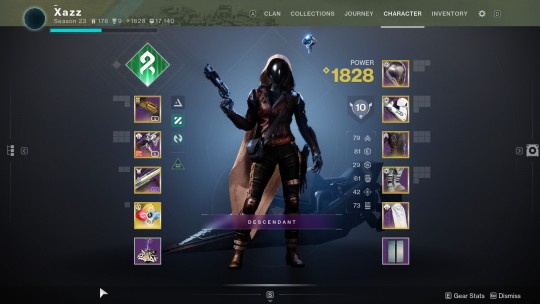
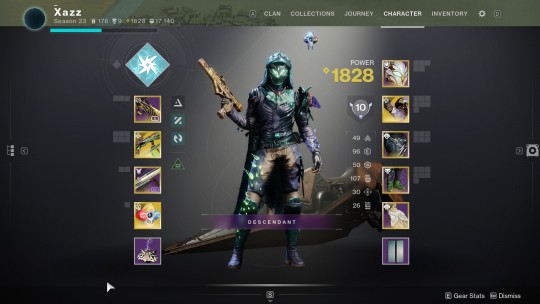

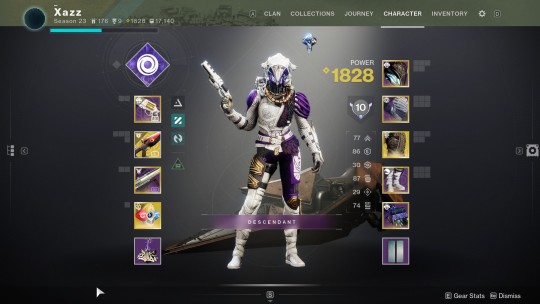
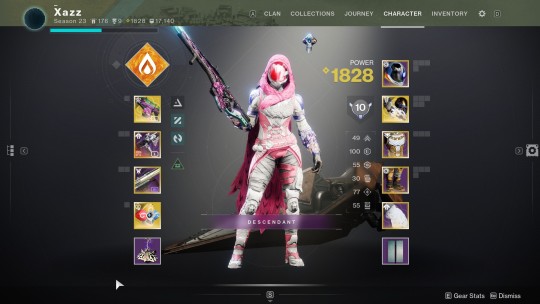

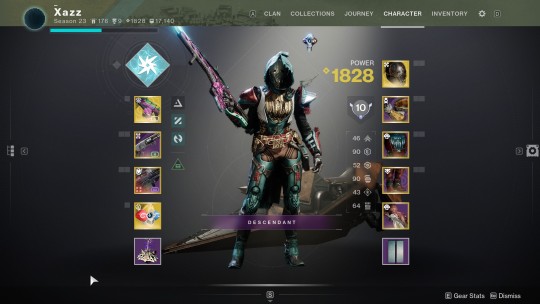
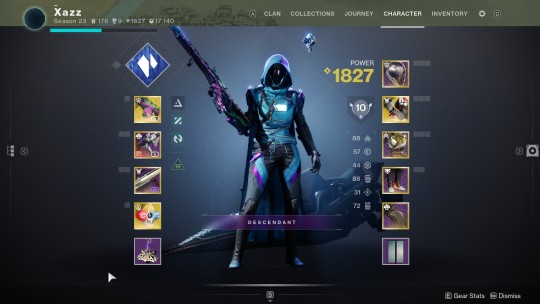
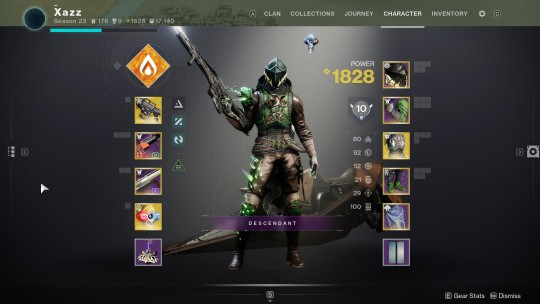
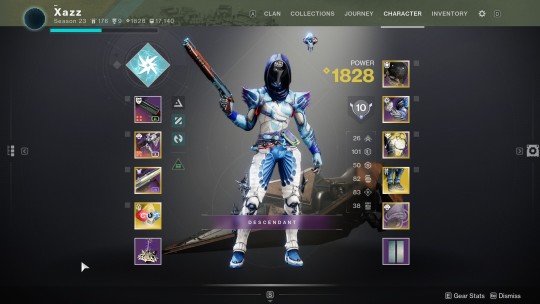
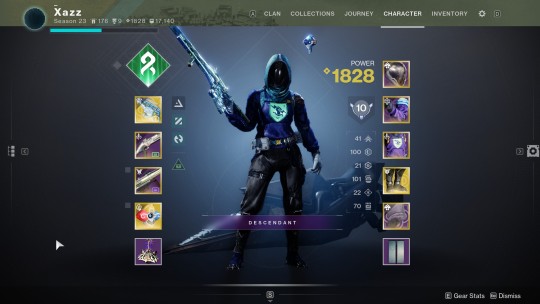
Legion duds. No real Build. Can use multiple exotics but I'm a weirdo and can be happy without an exotic. I swap out exotics as needed pretty generic Jack of All Trades Master of None style build bc I'm usually playing with @acel1en and I don't gotta think about it lol
So many moths. I have like... 100% grenade up time on the moths even when not using the Eris Gun. Just... so many moths. Blue moths, purple moths. All the moths!
'So I heard you need me on tether'. Generic Orpheus big tether build. I bring it out for raids/dungeons mostly. I just changed it's drip but I might need to again. Brown.
Hard Content/Stay Alive At All Costs/High Invis Uptime Build. Did the drip on this one a week or so ago and I love it. This comes out for GMs or fucking Simmumah because I can basically be invis forever. It's also the 'Ambulance' Build bc you go invis and revive your fireteam bc they DIED
Generic Lots of Blade Barrage Build. It's fun! Lots of super regen. Also she's so fucking cute! Spark of Joy my beloved. This replaced my YAS build after the nerf.
Toxic Strand Dive Build. I made it for PvP when threaded specter was really good. You go in deep, dodge out when you find someone nearby, the bombardiers damage the enemy and trigger the specter. Specter explodes and spawns threadlings. If the specter doesn't kill outright after the chip from the bombardiers the threadlings will get ya. It doesn't work all the time but BOY it's fucking funny when it does. Works good in PvE so long as I'm not playing with Ace bc he doesn't understand the concept of 'don't kill absolutely everything so I can get my silly build to work'.
Dance of Death Invis Arc Hunter. Pretty generic invis Arc Hunter for solo or team content. Good in lower level end game content like dungeons or raids. Great survivability if there's lots of trash mobs to kill. Produces Orbs of Light like it's its fucking job.
Generic Stasis Build. I am not good at piloting it at all XD Supposedly it gives me good resilience and has good survivability but I'm too stupid for it. I just wanna throw fucking supers man. It's my only Stasis build atm tho.
Fuck You Throwing Knife build. I'm not the best at piloting this one because you need to get into a groove with it. But once you get it you have unlimited throwing knives and your super builds up SUPER fast. It requires a bit more thinking than I often wanna keep track of.
Generic Fuck You Big Arc Build. You go up and punch things, make orbs, get Feast of Light 4 and slam your fucking stick into the nearest biggest pool of health points. Repeat. Generates a fuck ton of orbs but really relies on lots of ads to survive.
Newest build. All the Bey Blades. I made this build this week and it is INSANE. It makes so many tangles and in turn makes so many whirling maelstroms/beyblades. It's a very high risk build though since a lot of your tangles are made using grapple melee. Also has incredible uptime on the threaded spike. This build was just 'I wanna throw my knife a lot and make 1000 tangles'. It's so fucking fun in the Coil
10 notes
·
View notes
Text
Staunton Hall
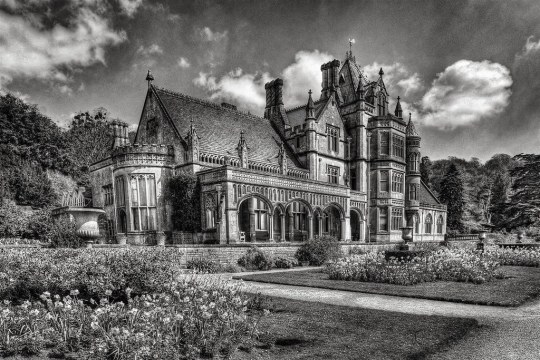


Estate Name: Staunton Hall
TLDR; the residence of Baron Edmund Staunton, and later Priscilla as well in the Baroness.
Location: Surrey, England (the same fictitious Surrey mentioned in Jane Austen's Emma and Sherlock Holmes)
The Manor: A grand Victorian Gothic Revival mansion, renovated in the 1860s, and owned by the Staunton family prior to Edmund inheriting it. It embodies the grandeur of the Victorian aristocracy, and its thrill-seeking inhabitant.
Notable Characteristics: Stained glass windows. Formal symetrical (Medici) gardens for promenading. A small rose garden that's personally overseen by the Baroness. Robust surrounding hunting grounds and forests with woodland walking paths and rolling hills (Edmund is big into hunting). A grand wood-paneled entrance hall, featuring a sweeping staircase. Paintings and artworks throughout - some statues are greek and roman originals. Mahogany bookcases with leather-bound volumes. A conservatory with exotic plants and a large birdcage. Edmund's office seemingly closed off.
Some parts of the manor are dark and dimly lit, and others more bright, like the house exudes chiaroscuro.
Outbuildings: Walled kitchen garden. Grand stables and carriage houses with luxurious horses, reflecting the style of the main house.
2 notes
·
View notes
Text

Day 133 — Majorca Building
The Majorca Building is an historic office building in Melbourne, completed in 1930 and located at 258-260 Flinders Lane. It was designed by architect Harry Norris who incorporated many American styles into his work. He was inspired by the then popular Spanish Colonial Revival style after visits to the United States. The building is laden with Spanish/Moorish features, including blue faience tiles; foliated (leaf shaped) and rope moulded ornaments, and a foyer featuring terrazzo and inlaid stone. The Moorish influence in its terracotta façade places it firmly within the Melbourne tradition of exotic architecture in the late 1920s.
The Majorca Building Company was formed in 1927, with the directors being Alfred and George Nicholas, who had made a fortune from 'Aspro' (aspirin), and built the nearby Nicholas Building in 1926, also designed by Norris. The brothers had been born in the hamlet of Majorca north of Ballarat, and likely named the company and the building after their home town.
In 1993 it was converted to residential apartments.
Photo: Foyer Entrance, Centre Place, 2021
0 notes
Text
Paradise Resort Kumarakom: A Journey into Kerala’s Timeless Charm
Kerala, fondly known as God’s Own Country, is renowned for its emerald backwaters, swaying coconut palms, and timeless cultural legacy. Nestled right in the heart of this tranquil paradise is Paradise Resort Kumarakom, a hidden gem that offers guests an immersive experience of Kerala’s heritage, beauty, and hospitality. If you're searching for the best resorts in Kumarakom, your journey begins—and ends—here.
A Living Reflection of Heritage
Paradise Resort is not just a place to stay—it’s an experience that revives the soul. As one of the most authentic heritage resorts in Kerala, it captures the essence of traditional Kerala living through its unique architecture, antique wooden furnishings, sloped tile roofs, open courtyards, and serene natural surroundings. The resort invites guests to step back in time while enjoying the finest comforts of modern luxury.
From the moment you arrive, you are welcomed with the warmth that Kerala is known for. Each cottage is designed in the style of Kerala heritage hotels, featuring elements that pay homage to the region’s rich history, art, and craftsmanship.
A Location That Steals Your Heart
Located in the picturesque village of Kumarakom—famous for its shimmering backwaters and lush greenery—Paradise Resort offers travelers the perfect setting to relax and reconnect with nature. Among the many hotels in Kumarakom, this resort is distinct for its peaceful ambiance and stunning views of Vembanad Lake.
Whether you want to take a leisurely boat ride across the backwaters, watch the sun dip into the horizon, or spot exotic birds at the nearby Kumarakom Bird Sanctuary, there is no shortage of soul-stirring experiences here.
Why Paradise Resort is Among the Best Resorts in Kumarakom
🏡 Traditional Kerala Cottages: Stay in aesthetically designed cottages that showcase local architecture and offer an authentic cultural feel.
🌴 Scenic Backwater Views: Wake up to the sound of nature and the view of still waters lined with palm trees.
🍛 Authentic Kerala Cuisine: Relish the flavors of Kerala with a variety of vegetarian and non-vegetarian delicacies prepared with homegrown ingredients.
🧘♀️ Ayurveda and Wellness Therapies: Rejuvenate your mind and body with expert Ayurvedic treatments that draw from centuries-old healing traditions.
🛶 Houseboat and Canoe Rides: Sail through the serene backwaters and experience the unique rhythm of life in Kerala.
🌿 Eco-Conscious Environment: Enjoy a sustainable stay that blends hospitality with harmony for nature.
The Heart of Kerala’s Hospitality
Being one of the most sought-after Kerala heritage hotels, Paradise Resort goes beyond offering luxury. It creates meaningful moments—whether you’re spending time with loved ones, celebrating a special occasion, or simply escaping the noise of everyday life.
The staff at Paradise Resort Kumarakom are known for their attentive service, genuine smiles, and deep commitment to making every guest feel like family. Whether you're on a romantic honeymoon, a family vacation, or a solo spiritual retreat, the resort offers personalized experiences tailored to your needs.
Perfect for Every Kind of Traveler
For couples seeking a romantic getaway, Paradise Resort offers privacy, peace, and postcard-perfect views. Families can enjoy spacious rooms, gardens, and activities that engage both kids and adults. Solo travelers can find solace in yoga sessions, book-reading under a tree, or journaling by the lake.
Business travelers, too, find this an ideal escape to unwind, reflect, and recharge in a setting far removed from the hustle of city life. Truly, it is one of the best resorts in Kumarakom for all.
Book Your Stay at Paradise Resort Kumarakom Today
Whether you're planning your next holiday, looking for a weekend retreat, or exploring hotels in Kumarakom for a peaceful getaway, Paradise Resort offers a refreshing blend of culture, nature, and comfort. It’s not just a place to stay—it’s a destination to remember.
Step into one of the finest heritage resorts in Kerala and discover what it means to truly unwind in timeless beauty.
#best resort in kumarakom#luxury resort in kumarakom#luxury resort in kerala#kumarakom#resort in kumarakom
0 notes
Text
Animal Art in India: A Cultural and Creative Legacy
India’s artistic heritage is rich, diverse, and deeply rooted in nature—and at its heart lies a profound relationship with animals. From ancient rock shelters to contemporary galleries, animal art in India has served as a mirror of mythology, a symbol of power, and a voice for cultural identity.
This blog takes you on a journey through India’s animal-inspired art traditions, showing how animals have not only been muses, but storytellers of civilization.
A Timeless Beginning: Prehistoric Petroglyphs
The origins of animal art in India can be traced back to prehistoric times, with stunning examples in the Bhimbetka rock shelters in Madhya Pradesh. These 30,000-year-old paintings depict bison, elephants, deer, and other creatures of the wild—testaments to early humans’ dependence on and reverence for animals.
These works, rendered in natural pigments, reflect hunting scenes, animal behaviour, and the beginnings of symbolic expression.
Sacred Symbols in Ancient Temples
Animals are central to Hindu, Buddhist, and Jain art, often appearing in temples as vehicles (vahanas) of gods, symbols of cosmic order, or representations of virtues and vices.
Nandi the bull, the mount of Lord Shiva, stands guard at countless Shaivite temples.
Garuda, the eagle-like mount of Vishnu, symbolizes speed, protection, and divine might.
Elephants, associated with Lord Ganesha, represent wisdom, strength, and auspiciousness.
Lions, found in Buddhist stupas like Sanchi, denote power and guardianship, and famously appear on India’s national emblem.

These animals are not merely decorative; they are alive with narrative—each one a metaphor for cosmic roles and moral messages.
Folk and Tribal Traditions: Living with the Wild
India’s folk and tribal communities have long held a close connection to wildlife, and their art reflects a profound respect for the animal kingdom.
1. Madhubani (Mithila) Art – Bihar
Often featuring elephants, birds, fish, and snakes, Madhubani paintings blend mythology and nature. Animals are drawn in vibrant patterns and filled with symbolic detail.
2. Gond Art – Madhya Pradesh
The Gond tribe sees animals as spiritual beings. Their paintings depict tigers, deer, peacocks, and mythical creatures in stylized, dotted patterns that tell stories of harmony between humans and nature.

3. Warli Art – Maharashtra
Warli painters use basic geometric shapes to depict daily life, where animals like cattle and dogs appear as part of village life and ceremonial processions.
4. Pattachitra – Odisha and West Bengal
This scroll-based art features mythological animals like Gajendra (the divine elephant) and Krishna’s cows, rendered in intricate and graceful detail.

In all these styles, animals are not exotic others, but familiar neighbours, often regarded as divine, ancestral, or moral companions.
Mughal Miniatures: Royal Grace and Natural Study
During the Mughal era, animal painting reached new heights of realism and detail. Court artists under emperors like Akbar and Jahangir documented tigers, cheetahs, elephants, and exotic birds with remarkable accuracy.

These paintings served not only decorative purposes but also scientific and political ones—showcasing the emperor's knowledge of the natural world and his dominion over it.
Mughal miniatures often show animals in courtly hunts, symbolic of power, or as subjects of serene beauty in gardens and wildlife studies.
Contemporary Animal Art: Revival and Awareness
Today, Indian artists continue to explore animal themes, but with modern media and urgent messages. Contemporary animal art in India often addresses:
Wildlife conservation and environmental loss
Urban-animal conflicts
Cultural nostalgia and disappearing traditions
Artists like Baiju Parthan, Bhajju Shyam, and younger wildlife illustrators are reinterpreting traditional animal forms through installations, digital media, and global exhibitions.

Meanwhile, animal figures remain central in Indian crafts—embroidered onto textiles, carved into wood, molded in terracotta, or cast in bronze.
Why Animal Art in India Still Matters
In a country of immense biodiversity and ancient reverence for life, animal art is more than visual expression—it's an ethical and spiritual language.
It connects rural and urban, old and new, sacred and secular. It reminds us that animals are not just part of India's landscape, but its soul—woven into its stories, prayers, and creative pulse.
Final Thoughts
From the timeless elephants of temple carvings to the folk tigers of tribal scrolls, animal art in India is a living tradition, one that evolves with its people while honouring its origins. As India faces ecological challenges, this art becomes both homage and hope—a reminder of coexistence, and a call for compassion.
visit our website and explore variety of artworks by renowned artist's.
instagram.com/zigguratss
#uy Original Paintings Online Indian Art Pieces Online#Explore Unique Online Paintings#Shop Exclusive Contemporary Art#Buy Original Indian Art Online#Traditional Indian Artwork Store#Modern Art Paintings for Home#Discover Affordable Art Online#Vibrant Canvas Paintings for Sale#Abstract Art Pieces Online India#Authentic Indian Art Prints#High-Quality Oil Paintings India#Watercolor Art Collections Online#Handcrafted Indian Artwork#Online Art Gallery Experience#Folk Art Paintings from India#Captivating Wildlife Paintings#Indian Heritage Art for Sale#Customized Artwork Online#Budget-Friendly Canvas Prints#Exciting Deals on Art Online#Meet Talented Indian Artists#Experience Indian Abstract Art#Serene Landscape Paintings#Exclusive Collections for Home#Artistic Gifts for Every Home#original artwork#paintings#sculptures#original serigraph art#Drawings
0 notes
Text
305Hydrolux: Premium Car Detailing Services in Doral, FL for the Ultimate Shine and Protection
Introduction:
In a city as vibrant and fast-paced as Doral, Florida, vehicles are more than just a means of transport—they are a reflection of personal style, professionalism, and pride. Maintaining that pristine showroom look, however, requires expertise, attention to detail, and a commitment to quality. That’s where 305Hydrolux comes in—a name synonymous with excellence in car detailing in Doral FL, where convenience meets craftsmanship. Our mobile solutions are built for those who demand the best and settle for nothing less when it comes to the care of their vehicle.
Craftsmanship Meets Technology: Our Detailing Philosophy
At 305Hydrolux, we believe that detailing is more than just a cleaning service—it’s an art form that brings out the personality of your vehicle while preserving its long-term value. Our team of trained professionals is passionate about cars and dedicated to delivering elite-level auto detailing in Doral Florida, utilizing premium products, cutting-edge equipment, and industry-best techniques.
Whether it's restoring faded paint, reviving interiors, or removing stubborn contaminants, we tailor every service to the specific needs of your car. From luxury sedans and family SUVs to sports cars and exotic vehicles, our approach ensures immaculate results every time.
Why Choose 305Hydrolux?
✔ Expert-Led Services
Our experienced detailers are not only trained in modern techniques but also continually update their knowledge to stay ahead of the curve. You can trust us with high-end vehicles, delicate finishes, and intricate interiors.
✔ 100% Mobile Car Detailing in Doral
We come to you—at home, the office, or anywhere in between. Our mobile services are designed around your schedule, allowing you to experience premium mobile car detailing in Doral without disrupting your day.
✔ Eco-Conscious Practices
We are committed to environmental responsibility. By using water-efficient methods and eco-friendly products, we reduce waste while still delivering a thorough clean and polish.
✔ Tailored Packages
Whether you're looking for a basic exterior wash or a comprehensive deep clean inside and out, we offer customizable packages to fit your needs and budget.
Our Services at a Glance
1. Exterior Detailing
Hand wash and drying
Clay bar treatment
High-gloss wax application
Paint correction and polishing
Ceramic coatings
2. Interior Detailing
Deep vacuuming
Carpet and upholstery shampoo
Leather conditioning
Dashboard and panel protection
Odor removal treatment
3. Engine Bay Cleaning
Degreasing and detailing the engine area
Safe, non-corrosive cleaning agents
Enhancing resale value and performance perception
4. Paint Protection Services
Ceramic coatings for extended protection
Paint sealants to lock in shine
UV protectants to prevent fading and oxidation
5. Fleet Detailing We also offer tailored plans for companies that manage a fleet of vehicles. Keep your business image sharp with consistent, high-quality auto detailing in Doral Florida.
The Mobile Edge: Bringing the Detail Shop to You
In today’s world, convenience is king—and our mobile car detailing in Doral offers exactly that. Our fully equipped mobile units bring the power of a professional detailing shop to your doorstep. No need to drive around, wait in line, or coordinate pick-up and drop-off. With 305Hydrolux, high-end detailing is just a call or click away.
We understand the value of your time and car, which is why our mobile units are designed to deliver the same attention to detail, sanitation, and perfection as an in-house studio. Our technicians arrive fully prepared, on time, and ready to transform your vehicle wherever you are.
What Makes Us the Preferred Choice in Doral, Florida?
305Hydrolux isn’t just a name—it’s a guarantee of excellence. With so many options available in the market, choosing the right detailing service can be daunting. Here’s why residents and businesses across Doral continually choose us:
Consistency in Quality: We never compromise. Every detail counts.
Client Education: We explain our process and help you understand how to maintain your car post-service.
Long-Term Protection: Our services aren’t just cosmetic; they enhance the longevity and value of your vehicle.
Passion for Cars: We treat your vehicle like it’s our own—with the utmost respect, care, and attention.
Maintaining the 305Hydrolux Standard at Home
While we’re always here when you need a professional touch, we also believe in empowering our clients. After a detailing service, we share best practices and tips to help you maintain that fresh, clean look longer:
Avoid automated car washes—they’re quick but often harmful to paint.
Use pH-neutral shampoos and microfiber towels for home washes.
Apply interior conditioners monthly to preserve materials.
Schedule regular professional details every 3-6 months for optimal results.
Serving More Than Just Private Vehicles
In addition to personal vehicles, 305Hydrolux proudly serves commercial clients, including:
Rideshare drivers (Uber, Lyft)
Corporate fleet managers
Real estate and client-facing professionals
Car rental companies
Dealerships needing showroom-ready vehicles
Whether you manage one vehicle or a fleet of fifty, our expert detailing ensures your assets always look their best.
Community Driven, Locally Rooted
As a business born and bred in Doral, we are proud to serve our community with integrity, dedication, and local flair. We support neighborhood events, local businesses, and believe in building relationships—not just transactions. When you choose 305Hydrolux, you're not just getting a detailer—you're partnering with a team that values the same community you call home.
A Luxurious Experience, Without the Premium Price Tag
Luxury detailing doesn’t have to break the bank. Our packages are priced competitively, with transparent quotes and no hidden fees. Quality service, delivered at your convenience, at a price that makes sense—that’s the 305Hydrolux promise.
0 notes
Text
HUgE Aug 2012
LATEST NEWS REVIEW NEXT UP

A new model has been launched by JM WESTON, a shoe house representing French trad. The name of this collection is taken from the most prestigious public school in the UK. It features a sharp silhouette with no unnecessary details and an elegantly rounded toe. It is elegant yet has a casual nuance. In addition to the loafers with monk straps, the design by Michelle Perry stands out, and there are 4 types such as wing tips. From the left: ¥101,850, ¥112,360 (JM WESTON)

"FOR RETURN TO THE STARTING POINT"
DIESEL BLACK GOLD showed its first men's wear show at the 2012 Fall/Winter Milan Collection. The memorable runway show depicted the image of a man that could be called the origin of the brand. A masculine style that mixed military and vintage elements. A modern sensibility and details were added to classic items such as peacoats and double-breasted jackets to create an urban wardrobe. The leather riders jacket, which appeared many times on the runway, was the most popular item. Although it has a simple design, it is made of firm and lustrous dark navy calf leather. It adds a sexy nuance to the sophisticated silhouette. The bold metal zippers running down the arms and front are also distinctive. DIESEL BLACK GOLD returned to Milan, the brand's hometown, and powerfully established its own unique worldview. This is a piece that is truly worthy of this new stage. ¥158,550 (DIESEL JAPAN)

An exclusive shirt from Acne will be released at OPENING CEREMONY. Pre-orders are being taken in-store. The chic black and dark grey colour scheme is well balanced with a pop pattern featuring a heart motif. The light, chiffon-like material and relaxed silhouette make for a comfortable fit. Members who make reservations during the period will also receive double points at the time of purchase. Don't miss out on this special opportunity. ¥40,950 (OPENING CEREMONY)

MARC JACOBS' fragrance "Splash" will be released again this year in limited quantities. This summer, titled the "Tropical Collection," features the revival of "Rain," a fresh and transparent floral scent that was popular in the past. In addition, the lineup includes "Cumquat," which features an energetic citrus scent, and "Hibiscus," which is exotic and delicate. The bottle design, which has been redesigned into a simple and elegant cube glass, is also a highlight. 100ml each ¥7,245 (COTY PRESTIGE JAPAN)

The lineup is super strong, with Radiohead, The Stone Roses, James Blake and more. More news has come from FUJI ROCK FESTIVA L'12, which is attracting more attention than ever before. The FUJI ROCK COLLECTION, which conveys the concept of Fuji Rock through fashion, is making its comeback after two years. T-shirts designed by Jun Takahashi of UNDERCOVER will be sold exclusively online (www.greenonred.jp) and at the venue. A portion of the proceeds will be used for earthquake recovery efforts. ¥5,250 each (SMASH)

A gathering of the finest artists, including designers, stylists, and photographers, who are driving the current Japanese fashion scene. The website "TRAVERSE TOKYO" was launched to convey the universal value of things and "authenticity" by presenting products and works from their own unique perspective. Now, TENDERLOIN, led by Toru Nishiura, has produced a special item for the site. The latest model of the horseshoe ring, which is synonymous with TENDERLOIN, has been announced. What is particularly noteworthy is that the purity of the gold has been increased. While keeping the rugged design, the material has been upgraded from 8K to 18K. Furthermore, the special polishing finish gives it an exquisite shine. The ultimate ring has been completed, exuding an atmosphere of luxury and a sense of dignity. It is available in two face sizes and is released in limited quantities. It is a ring that is perfect for a man who can discern "authenticity". Left: ¥701,400, Right: ¥963,900 (TRAVERSE TOKYO)
"BEAUTIFUL BRIGHTNESS IN AUTHENTIC RING"
#my scans#fashion#2010s fashion#avantgarde#archive fashion#japanese fashion#diesel jeans#gold jewelry#undercover#jun takahashi#marc jacobs#acne studios#leather jacket#loafers
1 note
·
View note
Text
Roman Clay Painter Los Angeles
Introduction to Luxurious Wall Treatments
In the vibrant sprawl of Los Angeles, where innovation meets opulence, interior design has taken a turn toward the extraordinary. Among the city’s most captivating trends are Tadelakt Bathroom Los Angeles and the work of a Roman Clay Painter Los Angeles, two techniques that elevate spaces with texture and timelessness. Rooted in ancient craftsmanship, these finishes bring a touch of the exotic and the artistic to modern homes, transforming bathrooms and beyond into sanctuaries of style. This article uncovers their allure, application, and growing foothold in LA’s design landscape.
The Magic of Tadelakt in Bathrooms
Tadelakt Bathroom Los Angeles introduces a Moroccan marvel to the city’s homes—a waterproof, lime-based plaster that’s as functional as it is beautiful. Originating from the hammams of Marrakech, this finish is hand-troweled into a seamless, glossy surface that resists moisture while exuding warmth. In LA, where bathrooms double as personal retreats, it’s a perfect fit, turning showers and vanities into sculpted works of art. Its natural sheen, achieved through polishing with river stones and sealing with olive oil soap, offers a tactile luxury that synthetic materials can’t replicate.
Roman Clay: Painting with Depth
Across the city, a Roman Clay Painter Los Angeles crafts walls with a different kind of magic. This technique, inspired by ancient Roman stucco, blends lime, clay, and pigments into a thick, velvety plaster. Applied with
sweeping trowel strokes, it dries into a matte finish that ripples with depth, evoking the look of weathered stone or polished concrete. In Los Angeles, where bold aesthetics reign, it’s a favorite for statement walls in living rooms or bedrooms, offering a painterly texture that captures light and shadow in mesmerizing ways.
Why Tadelakt Thrives in LA Bathrooms
The rise of Tadelakt Bathroom Los Angeles reflects the city’s love for bespoke, eco-friendly design. Its water-repellent nature makes it ideal for LA’s humid coastal enclaves, while its breathability prevents mold—a boon in a climate that swings from dry to damp. Homeowners in areas like Santa Monica or the Hollywood Hills adore its organic feel, with earthy tones like ochre or sage blending seamlessly into modern or bohemian interiors. It’s a finish that ages gracefully, developing a patina that tells a story, aligning with LA’s penchant for spaces that feel both lived-in and luxurious.
The Craftsmanship of Roman Clay Painters
A Roman Clay Painter Los Angeles brings a sculptor’s touch to their work, layering the mixture to create a finish that’s both rugged and refined. The process is meticulous—each stroke builds texture, with artisans adjusting pressure and angle to achieve the desired effect. In LA’s design-forward homes, from Downtown lofts to Pacific Palisades estates, this technique adds a soulful contrast to sleek furnishings. Customizable in color and intensity, it allows painters to craft walls that feel like an extension of the city’s artistic heartbeat.
Blending Old World with New Design
Both Tadelakt Bathroom Los Angeles and the artistry of a Roman Clay Painter Los Angeles marry heritage with innovation. Tadelakt’s seamless application eliminates grout lines, offering a minimalist elegance that suits LA’s contemporary tastes, while its durability nods to practical luxury. Roman clay, with its rich, hand-finished look, complements the city’s eclectic mix of architectural styles—think Spanish Revival villas or mid-century gems. Together, they create interiors that feel timeless yet forward-thinking, a balance that defines Los Angeles living.
Challenges of Mastering These Techniques
Applying Tadelakt Bathroom Los Angeles or working as a Roman Clay Painter Los Angeles demands skill and patience. Tadelakt requires a steady hand and precise timing—too much polish, and it cracks; too little, and it dulls. The soap sealing process, unique to this finish, adds another layer of complexity, especially in LA’s variable humidity. Roman clay, meanwhile, cures slowly, testing an artisan’s endurance as they build depth over hours or days. Yet, these challenges yield rewards: surfaces that stand out for their authenticity and resilience in a city that values the extraordinary.
The Future of Specialty Finishes in LA
As Los Angeles continues to push design boundaries, Tadelakt Bathroom Los Angeles and Roman Clay Painter Los Angeles are set to evolve. Pre-mixed formulations could simplify Tadelakt for wider use, while eco-conscious innovations—like carbon-capturing limes—might greenify both techniques. In a city obsessed with wellness, Tadelakt’s natural antifungal properties could see it expand beyond bathrooms into spas or kitchens. Roman clay might inspire pop-up art installations, blending painting with plaster in public spaces. The future promises a deeper integration of these finishes into LA’s creative ethos.
0 notes
Text
0 notes
Text
Top Classic Car Shows in the US

Every year, car enthusiasts, industry professionals, and media gather at various auto shows to showcase vehicle collections across categories. While many shows highlight the latest models and automotive technology, others look to the past to celebrate unique classic vehicles like hot rods.
The Pebble Beach Concours D'Elegance occurring annually in California in the third week of August is among the nation's top classic auto shows. Originating from the French-based Concours D'Elegance, this show attracts car lovers globally and features the most lavish and unique vintage vehicles from all decades. The event celebrates car culture from old to modern-day exotic autos. The Pebble Beach Concours D'Elegance also celebrates history, heritage, technical merit, and automobile beauty and style.
The Woodward Dream Cruise, also one of America's largest auto shows, is а single-day event held each summer in Detroit. The show is a major occasion in the city for classic muscle car and hot rod fans. More than a million people attend the show yearly to see around 40,000 classic cars. As a communal event, all can enjoy watching these classic automobiles cruise the 16-mile stretch of Woodward Avenue.
The Iola Classic Car Show in Wisconsin is a unique, long-running car event in the US. The event is held annually in the second week of July for three days in a 300-acre venue. Car enthusiasts meet to share stories about their vehicle’s history. The event also features a car show, auctions, parts swaps, and live entertainment. Additionally, the show includes more than 2,500 vehicles - cars, trucks, and motorcycles - and numerous swap spaces for buying, selling, or trading automotive parts and related items. Original vehicles built before 1942 enjoy free entry.
The Eastern Regional Fall Meet auto show by the Antique Automobile Club of America (AACA) takes place in Hershey, Pennsylvania. Held every first weekend of October, the show venue hosts over 1,000 cars during the four-day event. Over 9,000 flea fair dealers also find the opportunity to sell antique automotive parts, accessories, and memorabilia.
Hot August Nights, а large car show, celebrates classic American cars of the 1950s and 1960s and rock and roll music. Occurring the first week of August in Reno, Nevada, it attracts hundreds of thousands of spectators and showcases about 5,000 classic vehicles. The event also features vintage trailer revival shows, drag races, and auctions.
Wells Motor Company, Avon Park, Florida’s sole Jeep, Chrysler, and Dodge dealership, hosts a classic and custom car show every year. The show features over 150 classic vehicles across various makes and models. Admission is free for both car owners and onlookers. Nearby, Sebring International Raceway enhances the event’s appeal with vintage car displays and scheduled races.
Every June, the Minnesota Street Rod Association (MSRA) organizes the Back to the 50’s Weekend. This popular classic car show at the Minnesota State Fairgrounds in St. Paul celebrates classic vehicles and hot rods. Attendees enjoy live music, an airplane flyover, a massive swap meeting with vendors featuring various offerings, and activities for kids. Recently, the event has grown to attract more than 12,000 classic vehicles and hundreds of thousands of automotive enthusiasts.
0 notes
Text
ChuCui Palace and the Contemporary Expression and Aesthetic Reconstruction of French Chinoiserie
In contemporary design, French Chinoiserie has re-emerged as an elegant and distinctive aesthetic, exemplifying cross-cultural artistic fusion. As an 18th-century European romanticized interpretation of Chinese culture, Chinoiserie reflects Western admiration for Chinese artistry while embodying the interplay between Eastern and Western aesthetics. With globalization and growing appreciation for multiculturalism, this exotic style has found new life in modern design.
Chinoiserie’s resurgence in contemporary design is due to its unique aesthetic tension — drawing inspiration from Eastern elements while incorporating Western artistic reinterpretation. It blends traditional Chinese elegance with European aristocratic grandeur, manifesting in fashion, interior décor, and jewelry design. With intricate patterns, symbolic Eastern motifs, and soft color palettes, Chinoiserie offers a refined and romantic lifestyle infused with cultural depth. Unlike traditional Chinese design, which tends toward solemnity and restraint, Chinoiserie emphasizes decorative richness and romanticism, using exaggerated interpretations of Eastern motifs to create a dreamlike and poetic ambiance.

Hand-Painted Ebony Chinoiserie Baroque Console Table,image source from 1stDIBS
A hand-painted ebony console table with gilded Baroque-style bronze detailing, inspired by late 17th- to early 18th-century European Baroque furniture, serves as an example of contemporary antique revival. The X-shaped cross-frame, a design element popular in Louis XIV-era tables, is reimagined with sleek, elegant lines and dramatic flair. The tabletop is adorned with vivid Chinoiserie scenes and intricate floral motifs, while the border features Baroque-inspired scrollwork and gilded edges, demonstrating the fusion of Chinoiserie’s elaborate charm and vintage appeal.

ChuCui Palace’s “Dancing in Clouds” Necklace
The ChuCui Palace jewelry brand epitomizes Chinoiserie in jewelry, notably through the “Dancing in Clouds” necklace, which fuses Chinese ink painting, expressive aesthetics, and Western gem-setting techniques. The design incorporates Rococo-inspired soft curves alongside traditional Chinese artistic restraint.
The necklace features a crane’s elegantly curved neck, an abstract representation of traditional Chinese freehand brushwork. This contemporary interpretation pays homage to Chinese calligraphic expression, aligning with Chinoiserie’s poetic vision. The pure, minimalist color palette reflects the crane’s symbolic purity in Chinese iconography, while the interplay of negative space and delicate contours enhances its visual tension and ink-inspired aesthetics. The composition balances intricate maximalist feather detailing with a minimalist abstract neck, amplifying the piece’s dramatic contrast and rhythmic movement.

Royal Tichelaar Makkum Delftware Lamps, image source from 1stDIBS
A pair of Royal Tichelaar Makkum Delftware lamps, handcrafted by Amitābha Studio, showcases Chinoiserie’s influence in ceramic design. The lamp bases repurpose hand-painted Delft vases (1940–1979) from the Netherlands’ oldest ceramics manufacturer, Royal Tichelaar Makkum.
The vases’ intricate patterns draw inspiration from traditional Chinese bird-and-flower paintings and porcelain designs. However, unlike conventional Chinese motifs, the composition emphasizes Baroque-inspired symmetry and Chinoiserie’s ornate maximalism. The **rich color palette — blue, green, and red ochre — **honors traditional Chinese blue-and-white porcelain aesthetics while employing Western shading techniques to enhance depth and ornamentation.
The revival of French Chinoiserie in contemporary design is not merely nostalgic but reflects a deeper exploration of cultural fusion in a globalized world. By reinterpreting Eastern elements and merging them with Western artistry, Chinoiserie enriches modern design with cultural heritage and artistic dynamism. Whether in furniture, jewelry, or interior décor, Chinoiserie continues to embody a refined, romantic aesthetic that transcends East-West artistic boundaries.
As cultural awareness and artistic sensibilities evolve, Chinoiserie is poised for continued innovation and reinvention. More than a historical style, it represents a cultural phenomenon, redefining aesthetic narratives by seamlessly blending past and present, East and West. With its timeless elegance and poetic depth, Chinoiserie will continue to shape global design trends, serving as a beacon of cross-cultural artistry and creative synthesis.
0 notes
Text

Dade City, in the rolling hills of eastern Pasco County, is a place where Southern hospitality can be felt. Established in 1889, this Nature Coast gem is the seat of Pasco County. Its downtown restaurants, antique and specialty shops, craft breweries, parks and recreational facilities are fun to visit – you may want to stay - and you will probably return. In recent years, Dade City has become synonymous with its largest event, the Annual Kumquat Festival. Kumquats are a marvelous fruit that is both sweet and sour. The whole town joins in this annual celebration held on the last Saturday of January, yet there are many reasons to visit this charming Nature Coast city any day of the week. The historic architecture The Atlantic Coast Line Railroad building in Dade City was constructed in 1912. Image by Diane Bedard On September 14, 1885, the first regular train of the Florida Central and Peninsular Railway passed through Dade City. A historic brick rail station, originally built in 1912, is on the National Register of Historic Places. Today, it houses a Heritage and Cultural Museum. If you want to read about the train depots throughout the Nature Coast, click here. The iconic Pasco County Courthouse was built in 1909, and a thriving downtown radiates from it. Designed by noted architect Edward Columbus Hosford in the Classical Revival style, it is also on the U.S. National Register of Historic Places. Visitors can view the common areas inside. The craftsmanship is impressive. The 1909 historic Pasco County courthouse is a Dade City icon and is registered on the the U.S. National Register of Historic Places. Visitors can look inside. Image by Diane Bedard. Dade City Educational Institutions and Attractions Two excellent educational institutions, St. Leo University and Pasco-Hernando State College, are located in the Greater Dade City area, as is the Pioneer Florida Museum. On the outskirts is an exotic animal attraction called Giraffe Ranch, a Tree Hoppers adventure park, SnowCat Ridge, and the Joy-Lan Drive In Theater, where you can see first-run movies or attend a swap meet on weekends. The Joy Lan Drive In Theater is an old-fashioned outdoor experience! Image by Diane Bedard But the real magic of Dade City, in my opinion, is the charm of its residents and proprietors. Dade City Shopping & Dining This is a place with local shopkeepers offering service and selection. Choose from several antique stores in the downtown area offering selections from primitive to ostentatious at all price points. It is really fun to go from shop to shop and see what is new in the “old stuff” while reliving memories from finding a toy, tool, or piece of art reminiscent of one's youth. Antique stores abound in Dade City. Image by Diane Bedard There are many specialty shops with a little of this and a little of that, including home décor and furniture, fashion and jewelry, whimsical gifts and cards, art and wine, an authentic Mexican market and taqueria, grocery items and more. Most of these shops offer modest prices and excellent service. Plan to stay for a meal because there are at least twenty restaurants to choose from! Sandwich shops and bakeries lead to fire-grilled gourmet and restaurants owned and run by top-chefs - all located within historic and sometimes eclectic buildings. A tea room decorates for each season across the street from a casual coffee shop that offers pottery classes. The variety of choices ensures that you will find what suits your palate and your wallet right in the courthouse square. Lunch on Limoges was famous for its servers wearing starched white uniforms and its open kitchen – but I always remember their Fairy Cake. Today, it is part of the Florida Cracker chain, called Florida Cracker Lunch on Limoges. The servers are in jeans and tee shirts, but the food quality and open kitchen remain. Dade City is a pet-friendly place, with regular events that include dog parades, and some restaurants offer outdoor seating and even a menu for your canine companion. A huge pet store offers everything from healthy treats to custom specialty items for visitors. The owners welcome your pets in the store and love to help solve diet and skin problems with their extensive line of products. There is a true community atmosphere here. Originally a farming community, you will find ranchers and farm workers traveling through or stopping in for a meal while visiting Dade City. Del Carmen is a special Mexican market and Taqueria. The interior mural is magnifico! Image by Diane Bedard Parks and Gardens Several parks are located in the downtown area, including Hibiscus Park and Price Park, which offers more traditional city recreation including playground equipment, racquetball and tennis courts, and picnic tables with barbecue grills. There is a strong Garden Club in Dade City, contributing to the City's beauty and charm with certified Butterfly Gardens. The Dade City Garden Club puts on a Monarch Butterfly Festival in Polly Touchton Park annually, and Dade City is a Monarch City USA. Mona Goossens is receiving her Monarch Haven Plaque and certificate from the Dade City Garden Club for creating a friendly habitat for the winged pollinators. Image by Diane Bedard. Enjoy the historic buildings as you meander around. Historic storefronts abound. It can be fun to discover what’s inside, such as exposed brick walls from the early 1900s. Sometimes, one visits a place and not everyone wants to shop; Then what? Dade City has a nice cigar bar, sports bars, coffee shops, and local craft breweries for refreshment and relaxation options. The Spoke Visitor Center was built along the Hardy Trail extension to welcome trail users to Dade City. Image by Diane Bedard. Riding in and Through Dade City The bicycle riding community is welcome in Dade City. The multiuse Hardy Trail segment was completed in 2020, connecting Dade City to the Withlacoochee Trail (albeit in a bike lane along Hwy. 301). An air-conditioned Welcome Center called "The Spoke" was built at 37800 Church Avenue to provide a respite for bicyclists and hikers, and a splash pad is in the adjacent park's lovely location. The building is not always open, however. Groundbreaking for the 2,500-square-foot splash pad was held in April 2023, and planned features include an Aqua Dumping Bucket, Aqua Water Castle, aqua features such as jellyfish, a crab and butterfly, and even an aqua kumquat tree! This is all part of a bigger project developing a lovely park on Church Street. Plan to attend the Annual Kumquat Festival each January This family-friendly festival celebrates wonderful creations from the delicious kumquat citrus fruit. The whole town gets involved. Image by Gary Hatrick Dade City plays host each year to a large number of popular community-sponsored events, including the Kumquat Festival, Church Street Christmas, the aforementioned Monaerch Butterfly Festival, Dog Days in the Park, and the Country Christmas Stroll. A former Main Street organization, the Dade City Merchants Association puts on several events throughout the year, including a monthly Car Cruise In around the Courthouse Square from September through May. There is a strong Chamber of Commerce that provides visitor information and business promotion. A nice Hampton Inn is south of downtown if you decide to stay overnight because you simply want to see more than one day will accommodate. Stop in and visit Dade City. Florida Cracker Lunch on Limoges is a popular restaurant in Dade City. There are several excellent restaurants in the downtown area. Plan to visit for an event and stay to enjoy the leisurely pace and friendly residents. You’ll be glad you did. Read the full article
0 notes
Text
Great Hardwood Flooring Services Inc

Elevate Your Space with Expert Flooring Solutions in Glen Ellyn, Chicago, and Westchester, IL
When it comes to enhancing the beauty, functionality, and value of your home, choosing the right flooring is crucial. At Great Hardwood Flooring Services Inc, we specialize in delivering premium flooring solutions across Glen Ellyn, IL, Chicago, IL, and Westchester, IL. Whether you need hardwood floor installation, refinishing, or vinyl plank flooring, our team is dedicated to providing exceptional craftsmanship tailored to your needs.
Why Choose Great Hardwood Flooring Services Inc?
Expertise & Experience – With years of industry experience, our skilled professionals handle every project with precision and care.
Comprehensive Flooring Solutions – From installation to refinishing, sanding, and laminate flooring, we offer a full suite of services.
High-Quality Materials – We use only the best hardwood, laminate, and vinyl plank flooring materials to ensure durability and aesthetic appeal.
Customer Satisfaction – Our team prioritizes customer needs, delivering seamless service from consultation to completion.
Hardwood Flooring Installation Services
Hardwood floors add warmth and timeless elegance to any home. Our experts install a variety of hardwood flooring styles, from classic oak and maple to exotic woods. We ensure flawless fitting, long-lasting results, and a stunning finish that elevates your space.
The Installation Process:
In-home consultation to assess your space and flooring needs.
Selection of the best hardwood flooring option tailored to your lifestyle and budget.
Professional installation ensuring precision and efficiency.
Post-installation inspection and maintenance tips to enhance longevity.
Wood Floor Refinishing Services
Over time, hardwood floors can lose their shine due to scratches, wear, and tear. Our refinishing services in Chicago, Glen Ellyn, and Westchester restore the original beauty of your floors without the need for replacement.
Refinishing Benefits:
Removes deep scratches, stains, and discoloration.
Revives the natural beauty of wood.
Enhances durability and lifespan.
Increases property value.
Our team uses eco-friendly, dust-free sanding techniques and high-quality finishing products to bring your floors back to life.
Flooring Contractor Services
Looking for a reliable flooring contractor in Chicago, IL? We handle all aspects of floor installation and refinishing with professionalism and expertise. Whether you're remodeling a single room or upgrading an entire property, our licensed contractors deliver impeccable results tailored to your vision.
Floor Sanding & Refinishing
For homeowners in Westchester, IL, who want a cost-effective way to refresh their flooring, our sanding and refinishing services are the perfect solution. We use advanced sanding techniques to strip away imperfections, followed by refinishing that enhances your floor’s natural grain and luster.
Our Process:
Inspection & Preparation – We assess the floor’s condition and prepare it for sanding.
Dust-Free Sanding – Removes old finishes and evens out the surface.
Staining & Sealing – Applies custom stains and protective coatings.
Final Inspection – Ensuring a flawless, smooth finish.
Laminate & Vinyl Plank Flooring Installation
For those looking for stylish yet budget-friendly alternatives, we offer laminate flooring installation in Chicago, IL, and vinyl plank flooring installation in Westchester, IL. These options provide the look of real wood with added durability and easy maintenance.
Benefits of Laminate & Vinyl Plank Flooring:
Resistant to moisture and wear.
Wide range of styles and finishes.
Cost-effective and easy to maintain.
Quick and hassle-free installation.
Why Local Homeowners Trust Us
Our commitment to quality, affordability, and customer satisfaction has made us a top choice for flooring services in Glen Ellyn, Chicago, and Westchester. We take pride in transforming homes with beautiful and durable flooring solutions that stand the test of time.
Get a Free Consultation Today!
If you're ready to upgrade your flooring, Great Hardwood Flooring Services Inc is here to help. Contact us today for a free consultation and let us bring your flooring vision to life with expertise and care.
0 notes